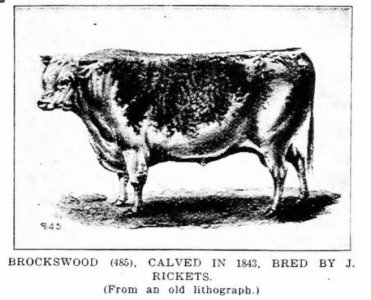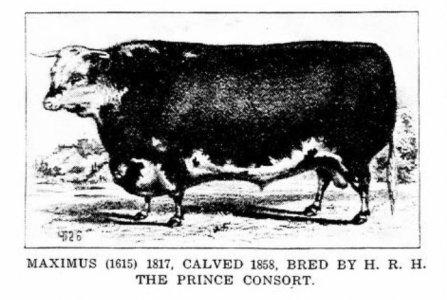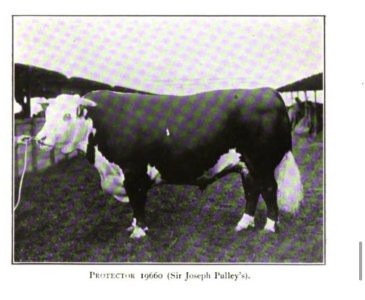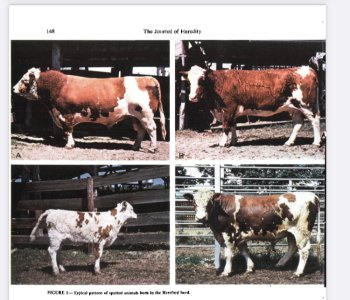You are using an out of date browser. It may not display this or other websites correctly.
You should upgrade or use an alternative browser.
You should upgrade or use an alternative browser.
Did I get a Hereford Visit
- Thread starter FlyingLSimmentals
- Start date

Help Support CattleToday:
Lee VanRoss
Well-known member
- Joined
- Apr 26, 2020
- Messages
- 2,392
- Reaction score
- 2,682
and the 7/8ths ?View attachment 17851
The calf on the right is a whole 1/8th hereford
Jeanne - Simme Valley
Well-known member
Simme explained the black/red gene perfectly.
I will debate the spotting gene. The face, legs, bellie, tail are all a different gene (very complicated - I haven't figured out).. A "spot" is considered on the body fully surrounded by a color. It is a recessive gene. Must inherit 2 genes to have a spot or spots expressed.
Breed a WF to a WF and all kinds of white will show up - but "should" not be related to SPOTS.
I will debate the spotting gene. The face, legs, bellie, tail are all a different gene (very complicated - I haven't figured out).. A "spot" is considered on the body fully surrounded by a color. It is a recessive gene. Must inherit 2 genes to have a spot or spots expressed.
Breed a WF to a WF and all kinds of white will show up - but "should" not be related to SPOTS.
FlyingLSimmentals
Well-known member
Jeanne - Simme Valley
Well-known member
Yup - that's a SPOT. Very traditional spot, over the shoulder. So, you are guaranteed that the dam and sire carry the spotting gene. And all the other chrome genes!!! LOL
Coat color genetics is far more complicated than most believe. Many genes for cattle color are all at different gene locations and it's not as simple as color x is always dominant over color y.
There have been both red as well as a separate white gene that have been identified and are dominant of so called "dominant black "
The white coloration on Herefords is not a spoting gene and the white is an accumulative mutation.
There have been both red as well as a separate white gene that have been identified and are dominant of so called "dominant black "
The white coloration on Herefords is not a spoting gene and the white is an accumulative mutation.
Ky hills
Well-known member
I had a purebred Hereford bull out of registered Hereford bull and cow, that I always said was proof that Herefords at some point mixed some Simmental in their gene pool.
That Hereford bull phenotypically looked a lot like your bull there.
He sired a lot of white, often white legs like that bull, and a couple of his calves out of certain "pure" Hereford cows had that shoulder stripe only more pronounced. They had it from the top line all the way down and one calf had it on both sides.
Nesikep
Well-known member
both are nearly the same.. both are half Gelbvieh, one on the right (Orphan) is 1/4 Shorthorn 1/4 Herf, on the left hes got a little shorthorn and Salers as well.and the 7/8ths ?
While the white pattern in herfords is an accumulative phenotype there have been documented white recessive spotting genes in certain herford lines.I had a purebred Hereford bull out of registered Hereford bull and cow, that I always said was proof that Herefords at some point mixed some Simmental in their gene pool.
That Hereford bull phenotypically looked a lot like your bull there.
He sired a lot of white, often white legs like that bull, and a couple of his calves out of certain "pure" Hereford cows had that shoulder stripe only more pronounced. They had it from the top line all the way down and one calf had it on both sides.
Have you seen the phenotype description of the early herfords and drawings of some of the early prominent animals of the breed?
Travlr
Well-known member
Post some. I'd like to see them.While the white pattern in herfords is an accumulative phenotype there have been documented white recessive spotting genes in certain herford lines.
Have you seen the phenotype description of the early herfords and drawings of some of the early prominent animals of the breed?
greybeard
Well-known member
https://www.herefordcattle.org/our-history/Post some. I'd like to see them.
scroll along the timeline and you'll see plenty
Travlr
Well-known member
That Lord Wilton bull, 1875, puts a lot of present day bulls to shame.
greybeard
Well-known member
Lord Wilton sold in 1884 for £3990 (British pounds) In today's USD, that would be right around $543,000 USD.That Lord Wilton bull, 1875, puts a lot of present day bulls to shame.
Herefordshire Through Time - Welcome
Information about cattle farming in Herefordshire in the Post-Medieval period
htt.herefordshire.gov.uk
greybeard
Well-known member
Notice how beefy the old bulls were..in the foreqtrs?
Way back then, the front is where most of the beef came from in all breeds.
Anxiety 4 changed all that.
Way back then, the front is where most of the beef came from in all breeds.
Anxiety 4 changed all that.
Not surprising when you look at the historical context. Herefords originated in at least in part from a draft breed.Notice how beefy the old bulls were..in the foreqtrs?
Way back then, the front is where most of the beef came from in all breeds.
Anxiety 4 changed all that.
Most of the west usa was settled as a result of as many if not more oxen then horses as far as draft animals.
Once mechanical machinery entered the picture the demand for draft animals or even multi purpose animals decreased.
Why would breeders continue to focus on heavy front quarters on an animal that no longer needed them?
Front quarters of beef are the toughest and least desirable/lowest cost cuts.
So why focus on increasing/maintaining the size of the least desirable cuts of beef. And the increased cost and feed required to produce them?
Travlr
Well-known member
I've always wondered if the tougher cuts in the rear (round?) might be less tough if the carcass was hung differently. With all the muscles relaxed instead of some bunched up.Not surprising when you look at the historical context. Herefords originated in at least in part from a draft breed.
Most of the west usa was settled as a result of as many if not more oxen then horses as far as draft animals.
Once mechanical machinery entered the picture the demand for draft animals or even multi purpose animals decreased.
Why would breeders continue to focus on heavy front quarters on an animal that no longer needed them?
Front quarters of beef are the toughest and least desirable/lowest cost cuts.
So why focus on increasing/maintaining the size of the least desirable cuts of beef. And the increased cost and feed required to produce them?







